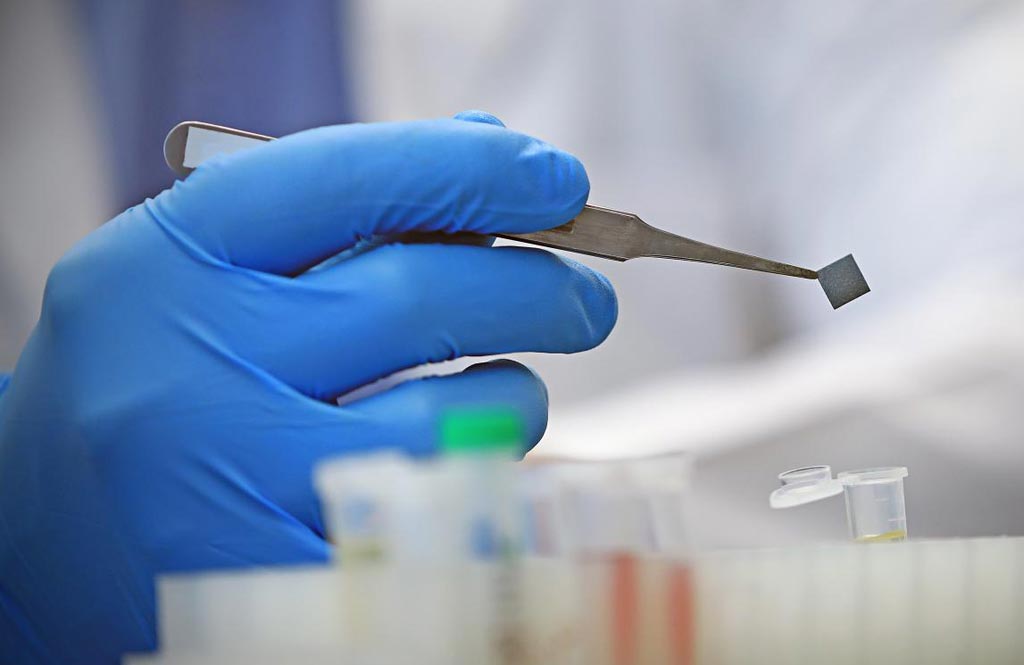Biosensor Device Developed for Zika Diagnosis
By LabMedica International staff writers
Posted on 21 Aug 2017
A novel plasmonic biosensor-based detection system was developed that can diagnose recent or current Zika virus (ZIKV) infection in 15 minutes or less.Posted on 21 Aug 2017
The ongoing Zika virus epidemic demands a response based on rapid, low-cost, and accurate diagnostic tests that can be broadly distributed and applied in pandemic regions. Toward this end, investigators at Washington University (St. Louis, MO, USA) developed an innovative, adaptable, and rapidly deployable bioplasmonic paper-based device (BPD) for the detection of ZIKV infection, via quantification of serum anti-ZIKV-nonstructural protein 1 (NS1) IgG and IgM. BPD is based on ZIKV-NS1 protein as a capture element and gold nanorods as plasmonic nanotransducers.

Image: A bioplasmonic paper-based device (BPD) for the detection of Zika virus (ZIKV) infection, via quantification of serum anti-ZIKV-nonstructural protein 1 (NS1) IgG and IgM (Photo courtesy of James Byard).
Plasmonic resonance is a phenomenon that occurs when light is reflected off thin metal films, which may be used to measure interaction of biomolecules on the surface. An electron charge density wave arises at the surface of the film when light is reflected at the film under specific conditions. A fraction of the light energy incident at a defined angle can interact with the delocalized electrons in the metal film (plasmon) thus reducing the reflected light intensity. The angle of incidence at which this occurs is influenced by the refractive index close to the backside of the metal film, to which target molecules are immobilized. If ligands in a mobile phase running along a flow cell bind to the surface molecules, the local refractive index changes in proportion to the mass being immobilized. This can be monitored in real time by detecting changes in the intensity of the reflected light. In the current study gold nanorods acted as the plasmon resonance transducers.
In the new BPD, the NS1 protein was bound to gold nanorods mounted on a piece of paper that was then coated with protective nanocrystals. The nanocrystals protected the nanorods and allowed them to be stored without refrigeration. To perform the assay, the paper was rinsed with slightly acidic water, removing the protective crystals and exposing the protein mounted on the nanorods. A drop of the patient's blood was applied. If the patient had come into contact with the virus, the blood sample contained immunoglobulins that bound to the Zika virus protein. Binding of immunoglobulins from the blood sample caused the nanorods to undergo a slight color change that could be detected with a hand-held spectrophotometer.
Results of a small clinical study revealed that the BPD displayed excellent sensitivity and selectivity to both anti-ZIKV-NS1 IgG and IgM in human serum. In addition, excellent stability of BPDs at room and even elevated temperature for one month was achieved by the metal–organic framework (MOF)-based biopreservation technique.
"We are taking advantage of the fact that patients mount an immune attack against this viral protein," said senior author Dr. Jeremiah J. Morrissey, research professor of anesthesiology at Washington University. "The immunoglobulins persist in the blood for a few months, and when they come into contact with the gold nanorods, the nanorods undergo a slight color change that can be detected with a hand-held spectrophotometer. With this test, results will be clear before the patient leaves the clinic, allowing immediate counseling and access to treatment."
Details of the BPD were published in the August 10, 2017, online edition of the journal Advanced Biosystems.
Related Links:
Washington University













